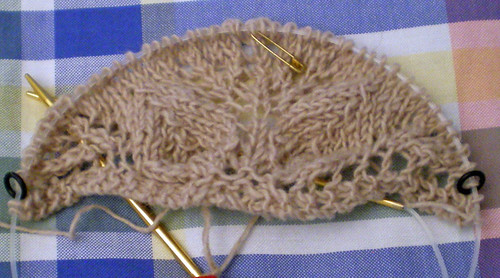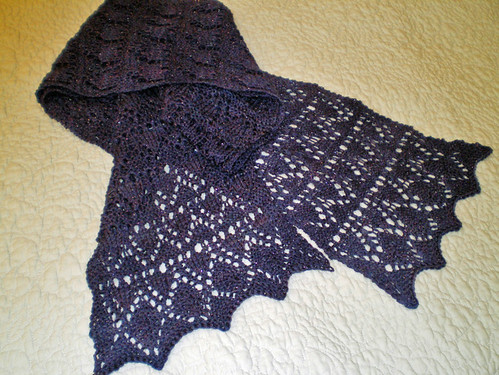My other two books finally came, Wrap Style by Pam Allen and Ann Budd, and Knitting Lace Triangles by Evelyn Clark.
 First the rap on Wrap Style. It has gorgeous pictures, clear instructions, but few items I want to knit. Most of them are short tight wraps or capelets, not shawls or larger wraps. I bought it primarily for Evelyn Clark's Shetland Triangle Shawl pattern, though Norah Gaughan's cabled capelet and Nancy Marchant's brioche stitch wrap have me itching to get my needles and worsted wool stash out (no pun intended; I'm OK with most wools, though Shetland wool right next to my skin makes me turn red). I'd make both of these longer though. There are general directions for designing your own capelet, but in general this book leaves me underwhelmed. Page numbers are hard to see: turned sideways and printed in light green ink. Not being spiral bound, I'm having a hard time keeping pages open to the charts I need, and the charts are small to begin with. We'll see how long it takes up valuable shelf space after I knit the shawl and maybe a capelet or two. Recommendation: Buy it if you love the patterns or foresee the need to knit wraps and capelets.
First the rap on Wrap Style. It has gorgeous pictures, clear instructions, but few items I want to knit. Most of them are short tight wraps or capelets, not shawls or larger wraps. I bought it primarily for Evelyn Clark's Shetland Triangle Shawl pattern, though Norah Gaughan's cabled capelet and Nancy Marchant's brioche stitch wrap have me itching to get my needles and worsted wool stash out (no pun intended; I'm OK with most wools, though Shetland wool right next to my skin makes me turn red). I'd make both of these longer though. There are general directions for designing your own capelet, but in general this book leaves me underwhelmed. Page numbers are hard to see: turned sideways and printed in light green ink. Not being spiral bound, I'm having a hard time keeping pages open to the charts I need, and the charts are small to begin with. We'll see how long it takes up valuable shelf space after I knit the shawl and maybe a capelet or two. Recommendation: Buy it if you love the patterns or foresee the need to knit wraps and capelets.
 On the other hand, Knitting Lace Triangles is a strategy for, well, knitting lace triangles into shawls or scarves, and includes general directions for knitting the same Shetland shawl as in Wrap Style (though the lace pattern is called something other than fir cone lace in Clark's own book). I like the spiral binding, allowing you to lay it flat as you knit. The charts are very clear and large. The instructions are quite good (that's true of most of Clark's patterns; I was able to knit her sock patterns as a sock neophyte). She gives several methods for starting a lace triangle, and I find that to be invaluable. In the back she gives information on approximate required yardage for several yarn weights. This is great for using up stash yarn. Since she planned the triangles in multiples of 10 rows, it's easy to modify sizes by knitting more or fewer 10 row repeats. if you want to add beads to the points of your edging, there are close-up photos and clear instructions for that too, and the chart in the back tells you about how many beads you need, whether you add 1 or 3 beads per point of edging. If you're getting into lace knitting, this book is pretty good to have. It's not as advanced as other lace knitting books, so you won't be frustrated and will complete your project. The edging is completed on the shawl, rather than casted on separated and then knitted to the shawl; I think this is easier for lace neophytes (at least for this one). Recommendation: A good book for lace neophytes or the geometrically-challenged to own.
On the other hand, Knitting Lace Triangles is a strategy for, well, knitting lace triangles into shawls or scarves, and includes general directions for knitting the same Shetland shawl as in Wrap Style (though the lace pattern is called something other than fir cone lace in Clark's own book). I like the spiral binding, allowing you to lay it flat as you knit. The charts are very clear and large. The instructions are quite good (that's true of most of Clark's patterns; I was able to knit her sock patterns as a sock neophyte). She gives several methods for starting a lace triangle, and I find that to be invaluable. In the back she gives information on approximate required yardage for several yarn weights. This is great for using up stash yarn. Since she planned the triangles in multiples of 10 rows, it's easy to modify sizes by knitting more or fewer 10 row repeats. if you want to add beads to the points of your edging, there are close-up photos and clear instructions for that too, and the chart in the back tells you about how many beads you need, whether you add 1 or 3 beads per point of edging. If you're getting into lace knitting, this book is pretty good to have. It's not as advanced as other lace knitting books, so you won't be frustrated and will complete your project. The edging is completed on the shawl, rather than casted on separated and then knitted to the shawl; I think this is easier for lace neophytes (at least for this one). Recommendation: A good book for lace neophytes or the geometrically-challenged to own.
To put theory into practice, I used a cast-on from Knitting Lace Triangles to start the Shetland Triangle shawl. I'm using Beaverslide Dry Goods light sport in Whitetail Fawn from stash and size 5 needles (6 would probably be a bit better but my size 6 needles are claimed by other WIPs; oh well). The garter tab at the base of the neck and the first 20 row pattern for the neck are complete:

BTW, this is my first time knitting with BDG light sport, previously I'd only knitted with the heavy worsted-weight yarn. Opinion? Lovely yarn but when I wound all 440 yards into one center-pull skein and tried to start the skein from the center, it snapped. So I'm unwinding from the outside as I knit. It's not plied (it's 1-ply), so joining may be slightly visible if I add another skein. It's called light sport, but fingering weight may be more accurate; it's described on the site as a 20 wpi yarn, 6-7 stitches per inch on a size 2 to 4 needle. I had bought it initially for a pair of socks, but even non-knitting DH (my human swift, who observed the snapping of the center strand) remarked that the yarn is not strong enough for socks. I agree. I think it's great for lace though. And I love the color. Moreoever, the yarn has some mohair and therefore isn't real slick. I think that will be an advantage as the number of stitches grows on the needles. There's a one pound cone of it in this color on sale on the website right now.
Front and back of Milkshake are done. Even after blocking, the back of Milkshake looks pathetic. I'm going to take out the big guns, er steam iron, and see if I can't flatten those seams better.
 Pathetic-looking, right? Wait 'til I take the iron to it.
Pathetic-looking, right? Wait 'til I take the iron to it.
OTOH, Carefree is looking more like something. Lovely depth to those staggered cables, just love them.




























